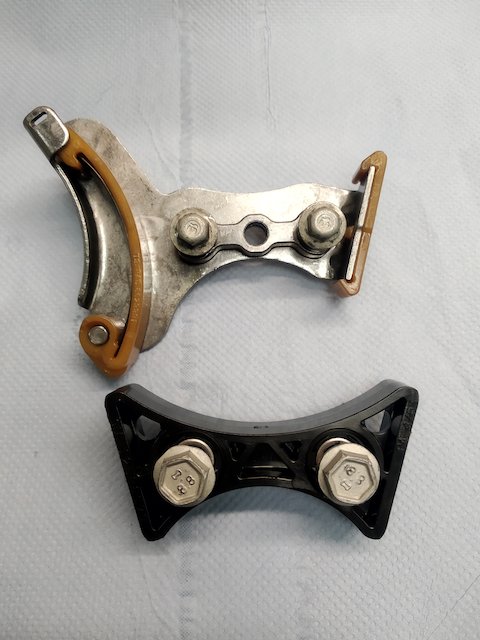Gen IV LS Timing Chain Tensioner Failure
A common and potentially catastrophic failure in Gen IV LS engines (L98, L76, L77, LS3, L99, LSA) is the OEM timing chain tensioner. The nylon guide is prone to breaking, even in low kms engines, releasing the steel spring. Debris forms as the nylon and steel fall into the moving timing chain, crank and cam gears. Although possible, it is very uncommon for the steel spring to cause the timing chain to jump a tooth. The much more common issue following the failure is the small pieces of nylon being sucked up into the oil pump pickup screen, blocking flow and causing oil pump cavitation and premature bearing wear and failure.
A broken timing chain tensioner, showing the snapped nylon guide and loose spring steel.
Having fallen into the chain path, debris from the broken nylon timing chain guide is sucked into the oil pump pickup causing blockage and oil starvation.
The OEM LS3 tensioner (top) is prone to failure. HBR recommends replacing it with the OEM LS2 damper (bottom).








The Gen III engines, including the LS1, had no tensioner or damper fitted from factory. The Gen IV LS2 received the timing chain damper that we now fit as a replacement to the later timing chain tensioner found in all other Gen IV engines including L98, L76, L77, LS3, L99 and LSA. The reason these parts were added by GM was to restrict the movement of the chain, with the aim to reduce noise and increase long term durability. The LS2 damper sits inside the chain loop and has no moving parts, so does not suffer from the issues of the tensioner while still adequately restricting chain movement.
If you fit a brand new OEM timing set to an LS engine you will notice a small amount of slack in the chain. When the engine reaches operating temperature all of the components grow slightly, with the distance between the crankshaft and camshaft centerlines also increasing. The chain slack that was present at ambient temperature will now be taken up. A common problem with aftermarket timing chain sets is that they have inadequate slack at ambient temperature, which causes an over-tight chain at operating temperature. This will quickly wear the teeth on the crank and cam gears which can be seen as a “shark fin” effect, reducing valve timing accuracy and placing unnecessary vertical and thrust loads through the crank and camshaft bearings.
If you have any questions regarding valve timing components for your LS engine, please contact us.


